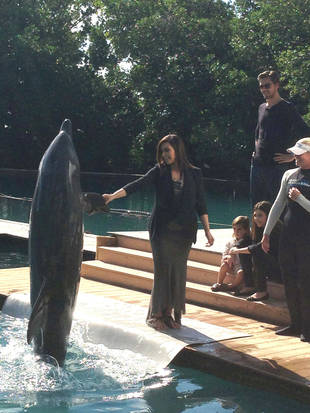5 Reasons Kim Kardashian Shouldn’t Support Dolphins in Captivity
In March 2012, Richard O’Barry wrote a letter to Jersey Shore star Nicole Polizzi –aka Snookie- after a photograph surfaced of her swimming with captive dolphin that lived (was caged) in a Mexican swim-with program.
Sadly, fellow reality star Kim Kardashian has followed in Snooki’s pro-captivity footsteps by visiting the Miami Seaquarium on December 7. Scope the picture of Kim fin-shaking with one of its captive dolphins lower.
Cove star Richard O’Barry—the grandfather of the cetacean abolitionist movement—wasn’t pleased by Kardashian’s appearance.
“These captive programs separate dolphins from their families and their ocean environments, so they spend a lifetime in cramped quarters, eat dead fish, and perform circus tricks for us, the public, who so misunderstand them and their needs,” he wrote on The Dolphin Project. “How would stars like it if they were put in boxes, only to be brought out to perform daily shows, doing dumb tricks, and then be paid by dead fish for dinner? Why do we treat these intelligent and family-oriented animals as if they were toys?”
Asked today by TakePart if he would be willing to take Kardashian on a boat into the open-ocean so she could view dolphins in their natural habitat, Miami-native O’Barry said “absolutely.”
“Most people are like her; they just don’t have the information about how abusive that industry is,” said O’Barry, to TakePart. “I worked there, I was the head trainer at the Miami Sequarium…people just need to see dolphins in the wild to see what’s wrong with captivity. Yes, I would take her out and would be happy to show her how dolphins actually live.”

Until that future sea-outing, Kardashian should ponder these five facts—the same ones he offered to Snooki some nine months ago.
Then, and maybe only then will the socialite understand that she should never again patronize an aquarium that keeps dolphins locked up in tiny tanks.
1) In the open waters of the boundless ocean, a free, wild dolphin can live up to 50 years. A caged dolphin, on the other hand, circles its tiny tank without purpose—often to the point of depression and suicide .
2) Even in the largest aquarium facilities, captive dolphins have access to less than 1/10,000 of 1 percent (0.000001) of the swimming area available to them in their natural environment. Compare this to the fact that some wild dolphin pods can swim up to 100 miles a day hunting for food, and you’ll begin to grasp why holding one captive in a tank amounts to nothing more than the cruel deprivation of basic cetacean rights.
3) It isn’t totally safe to swim with captive dolphins. They are wild animals and all wild animals, even if they appear to be smiling at you, are still unpredictable creatures. They can be moody. And while injuries in ‘swim-with’ attractions are uncommon, they do happen. A dolphin can bite, ram, or otherwise hit a person.
4) What about educating children on dolphins? How would I do that without dolphinariums or places like Sea World? I’ll leave it to famed ocean explorer Jacques Costeau to explain: “No aquarium, no tank in a marine land, however spacious it may be, can begin to duplicate the conditions of the sea. And no dolphin who inhabits one of those aquariums or one of those marine lands can be considered normal.”
5) While a good number of dolphins in U.S. dolphinariums and zoos are born and bred in captivity, many dolphinariums and swim-with programs in foreign countries still stock up by purchasing dolphins snatched from the wild. Many of these dolphins are taken during a barbaric ritual called drive-hunting. The most notorious drive-hunting spot on the planet is located in Taiji, Japan—the infamous Cove. As depicted in The Cove, Taiji fishermen lure between 1,500 and 2,000 dolphins into the shallows of the cove and separate out the ones deemed worthy of selling to an aquarium. The rest are bludgeoned to death with harpoons, and their meat is then sold in supermarkets. About 1,500 to 2,000 dolphins are killed in the cove each year as part of the country’s 20,000-dolphin quota.
Sign and share the petition to help save Japan’s Dolphins.
